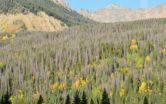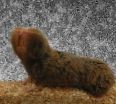(Press-News.org) Results of a new study show that episodes of reduced precipitation in the Southern Rocky Mountains, especially during the 2001-2002 drought, greatly accelerated a rise in numbers of mountain pine beetles. The overabundance is a threat to regional forests.
The research is the first to chart the evolution of the current pine beetle epidemic in the southern Rocky Mountains.
It compared patterns of beetle outbreaks in the two primary host species, the ponderosa pine and lodgepole pine, said University of Colorado at Boulder (CU-Boulder) researcher Teresa Chapman.
A paper on the subject is published in the current issue of the journal Ecology. Chapman is lead author of the paper; co-authors include CU-Boulder scientists Thomas Veblen and Tania Schoennagel.
The National Science Foundation (NSF) funded the research.
"This study confirms that warming temperatures and drought are likely triggers of the widespread bark beetle outbreaks that have devastated forests over vast areas of the West," said Richard Inouye, program director in NSF's Division of Environmental Biology.
"It also suggests why bark beetle outbreaks may vary for two different tree species," he said, "and how different forests may be more or less susceptible to these insects that are transforming mountain landscapes."
The current mountain pine beetle outbreak in the Southern Rockies--which ranges from southern Wyoming through Colorado and into northern New Mexico--is estimated to have affected almost 3,000 square miles of forests.
While the 2001-2002 drought in the West played a key role in pushing the pine beetle outbreak into a true regional epidemic, the outbreak continued to gain ground even after temperature and precipitation levels returned to levels nearer the long-term averages.
The beetles decimated lodgepole pine forests by moving into wetter and higher elevations and into less susceptible tree stands--those with smaller-diameter lodgepoles that share space with other tree species.
"In recent years some researchers have thought the pine beetle outbreak in the Southern Rocky Mountains might have started in one place and spread from there," said Chapman.
"What we found was that the mountain pine beetle outbreak originated in many locations. The idea that the outbreak spread from multiple places, then coalesced and continued spreading, really highlights the importance of the broad-scale drivers of the pine beetle epidemic, like climate and drought."
Mountain pine beetles range from Canada to Mexico and are found at elevations from sea level to 11,000 feet. These native insects have shaped the forests of North America for thousands of years by attacking old or weakened trees, resulting in younger forests.
The effects of pine beetle overpopulation are especially evident in recent years on Colorado's Western Slope, including Rocky Mountain National Park, with a particularly severe epidemic occurring in Grand and Routt counties.
The most recent mountain pine beetle outbreak began in the 1990s, primarily in scattered groups of lodgepole pines at low elevations in areas of lower annual precipitation.
Following the 2001-2002 drought, the outbreak was "uncoupled" from the initial weather and landscape conditions, triggering a rise in beetle populations on the Western Slope and propelling the insects over the Continental Divide into the Northern Front Range to infect ponderosa pine, Chapman said.
The current pine beetle epidemic in the Southern Rocky Mountains also was influenced by extensive forest fires that ravaged Colorado's Western Slope from roughly 1850 to 1890.
Lodgepole pine stands completely burned off by the fires were followed by huge swaths of seedling lodgepoles that eventually grew side-by-side into dense mature stands, making them easier targets for the pine beetles.
"The widespread burning associated with dry years in the 19th century set the stage by creating vast areas of trees in the size classes most susceptible to beetle attack," said Chapman.
Veblen said a 1980s outbreak of the pine beetle in Colorado's Grand County ended when extremely low minimum temperatures were reached in the winters of 1983 and 1984, killing the beetle larvae.
But during the current outbreak, minimum temperatures during all seasons have been persistently high since 1996, well above the levels of extreme cold shown to kill beetle larvae in laboratory experiments.
"This implies that under continued warming trends, future outbreaks will not be terminated until they exhaust their food supply--the pine tree hosts," said Veblen.
Chapman said there has been a massive and unprecedented beetle epidemic in British Columbia, which also began in the early 1990s and now has affected nearly 70,000 square miles.
"It is hard to tell if this current beetle epidemic in the Southern Rockies is unprecedented," she said. "While warm periods in the 16th century may have triggered a large beetle epidemic, any evidence would have been wiped out by the massive fires in the latter 19th century."
The rate of spread of the mountain pine beetle in lodgepole pine forests has declined in the southern Rocky Mountains during the past two years because of a depletion of host pine population.
But surveys indicate that the rate of beetle spread in ponderosa pine forests on the Front Range has increased sharply over the past three years.
The current study suggests that under a continued warmer climate, the spread of the beetle in ponderosa pines is likely to grow until that food source also is depleted.
"Our results emphasize the importance of considering different patterns in the population dynamics of mountain pine beetles for different host species, even under similar regional-scale weather variations," said Chapman.
"Given the current outbreak of mountain pine beetles on the Front Range, the effect on ponderosa pines is certainly something that needs further study."
INFORMATION:
Drought in 2001-2002 fueled Rocky Mountain pine beetle outbreak
Reduced precipitation in the southern Rockies turned outbreak into epidemic
2012-11-06
ELSE PRESS RELEASES FROM THIS DATE:
Controlling vascular disease may be key to reducing prevalence of Alzheimer's disease
2012-11-06
Amsterdam, NL, November 5, 2012 – Over the last 15 years, researchers have found a significant association between vascular diseases such as hypertension, atherosclerosis, diabetes type 2, hyperlipidemia, and heart disease and an increased risk of Alzheimer's disease. In a special issue of the Journal of Alzheimer's Disease, leading experts provide a comprehensive overview of the pathological, biochemical, and physiological processes that contribute to Alzheimer's disease risk and ways that may delay or reverse these age-related abnormalities.
"Vascular risk factors ...
Stirred not mixed: How seawater turbulence affects marine food webs
2012-11-06
New research shows that ocean turbulence directly affects the ability of microscopic marine organisms to recycle organic material back into the food web.
Results of the study are published in this week's issue of the journal Science.
Scientists John Taylor of Cambridge University and Roman Stocker at MIT found that there's a relationship between the natural movement of water in the ocean and the ability of marine bacteria to act as recyclers.
"The research provides a unique insight into how small organisms, such as bacteria, interact with their environment," says ...
Researchers discover how underground rodent wards off cancer
2012-11-06
Biologists at the University of Rochester have determined how blind mole rats fight off cancer—and the mechanism differs from what they discovered three years ago in another long-lived and cancer-resistant mole rat species, the naked mole rat.
The team of researchers, led by Professor Vera Gorbunova and Assistant Professor Andrei Seluanov, found that abnormally growing cells in blind mole rats secrete the interferon beta protein, which causes those cells to rapidly die. Seluanov and Gorbunova hope the discovery will eventually help lead to new cancer therapies in humans. ...
Researchers create laser the size of a virus particle
2012-11-06
A Northwestern University research team has found a way to manufacture single laser devices that are the size of a virus particle and that operate at room temperature. These plasmonic nanolasers could be readily integrated into silicon-based photonic devices, all-optical circuits and nanoscale biosensors.
Reducing the size of photonic and electronic elements is critical for ultra-fast data processing and ultra-dense information storage. The miniaturization of a key, workhorse instrument -- the laser -- is no exception.
The results are published in the journal Nano Letters.
"Coherent ...
Healthcare ethics consultants share lessons learned
2012-11-06
Healthcare ethics consultants are called upon in the most difficult of times; where do they turn for advice? The American Society For Bioethics and Humanities' Clinical Ethics Consultation Affairs Committee (CECA) is taking a community approach, creating an online forum for feedback and shared experiences to accompany a paper published in the Fall 2012 issue of the Journal of Clinical Ethics.
The paper, titled "HCEC Pearls and Pitfalls: Suggested Do's and Don'ts for Healthcare Ethics Consultants," compiles lessons learned and advice for best practices from members of ...
The Phosphorus Index: Changes afoot
2012-11-06
Phosphorus (P) is both an essential nutrient in agricultural fields and a contributor to poor water quality in surface waters. To encourage improved P management in fields, the P Index was proposed as a risk assessment tool in 1992. After 20 years of use, modifications, and growing pains, does the P Index accurately assess the risk of P loss?
A special section being published next month in the Journal of Environmental Quality addresses that question. The collection of papers grew out of a symposium at the American Society of Agronomy, Crop Science Society of America, ...
Is your memory playing tricks on you? Check your medicine cabinet!
2012-11-06
This press release is available in French.
Common medication to treat insomnia, anxiety, itching or allergies can have a negative impact on memory or concentration in the elderly, according to Dr. Cara Tannenbaum, Research Chair at the Institut universitaire de gériatrie de Montréal (IUGM, Montreal Geriatric University Institute) and Associate Professor of Medicine and Pharmacy at the University of Montreal (UdeM). Up to ninety percent of people over the age of 65 take at least one prescription medication. Eighteen percent of people in this age group complain of memory ...
Research Shows HAMP Fell Short for Many Homeowners
2012-11-06
According to current data, foreclosures continue to remain high all across the nation -- proof that the real estate market is far from stabilized. The Home Affordable Modification Program, known as HAMP, put forth in 2007, was designed to help homeowners modify their mortgage to a sustainable monthly payment and avoid foreclosure. However, data from a new study conducted at the Columbia Business School indicates that the initiative simply fell short and failed to help many borrowers.
Tomasz Piskorski, an Edward S. Gordon Associate Professor of Real Estate at Columbia ...
Dangers for Motorists Are Greatest at Intersections
2012-11-06
Ohio motorists who believe they are in most danger while driving at high speed on the state's highways would be mistaken. According to the Federal Highway Administration, drivers are at greatest risk of suffering serious personal injury in car accidents at intersections.
Statistics from the FHWA indicate that more than 2.8 million accidents at intersections are reported annually in the United States. These amount to over 44 percent of all reported accidents. Out of the nation's 33,808 traffic fatalities in 2009, 20.8 percent of them, a total of 7,043, occurred in accidents ...
Supreme Court to Decide Legality of DWI Warrantless Blood Tests
2012-11-06
The United States Supreme Court has recently agreed to hear a case that will have a far-reaching effect on the 1.4 million people who are arrested each year for driving while intoxicated. The issue that the court will decide is whether individuals who have been stopped on suspicion of DWI have a Fourth Amendment protection against compulsory blood tests.
The case is called Missouri v. McNeely. It began when a Missouri highway patrol officer pulled over Tyler McNeely for speeding. During the stop, the officer claims that McNeely exhibited signs of intoxication. In order ...
LAST 30 PRESS RELEASES:
Tracing the quick synthesis of an industrially important catalyst
New software sheds light on cancer’s hidden genetic networks
UT Health San Antonio awarded $3 million in CPRIT grants to bolster cancer research and prevention efforts in South Texas
Third symposium spotlights global challenge of new contaminants in China’s fight against pollution
From straw to soil harmony: International team reveals how biochar supercharges carbon-smart farming
Myeloma: How AI is redrawing the map of cancer care
Manhattan E. Charurat, Ph.D., MHS invested as the Homer and Martha Gudelsky Distinguished Professor in Medicine at the University of Maryland School of Medicine
Insilico Medicine’s Pharma.AI Q4 Winter Launch Recap: Revolutionizing drug discovery with cutting-edge AI innovations, accelerating the path to pharmaceutical superintelligence
Nanoplastics have diet-dependent impacts on digestive system health
Brain neuron death occurs throughout life and increases with age, a natural human protein drug may halt neuron death in Alzheimer’s disease
SPIE and CLP announce the recipients of the 2025 Advanced Photonics Young Innovator Award
Lessons from the Caldor Fire’s Christmas Valley ‘Miracle’
Ant societies rose by trading individual protection for collective power
Research reveals how ancient viral DNA shapes early embryonic development
A molecular gatekeeper that controls protein synthesis
New ‘cloaking device’ concept to shield sensitive tech from magnetic fields
Researchers show impact of mountain building and climate change on alpine biodiversity
Study models the transition from Neanderthals to modern humans in Europe
University of Phoenix College of Doctoral Studies releases white paper on AI-driven skilling to reduce burnout and restore worker autonomy
AIs fail at the game of visual “telephone”
The levers for a sustainable food system
Potential changes in US homelessness by ending federal support for housing first programs
Vulnerability of large language models to prompt injection when providing medical advice
Researchers develop new system for high-energy-density, long-life, multi-electron transfer bromine-based flow batteries
Ending federal support for housing first programs could increase U.S. homelessness by 5% in one year, new JAMA study finds
New research uncovers molecular ‘safety switch’ shielding cancers from immune attack
Bacteria resisting viral infection can still sink carbon to ocean floor
Younger biological age may increase depression risk in older women during COVID-19
Bharat Innovates 2026 National Basecamp Showcases India’s Most Promising Deep-Tech Ventures
Here’s what determines whether your income level rises or falls
[Press-News.org] Drought in 2001-2002 fueled Rocky Mountain pine beetle outbreakReduced precipitation in the southern Rockies turned outbreak into epidemic


